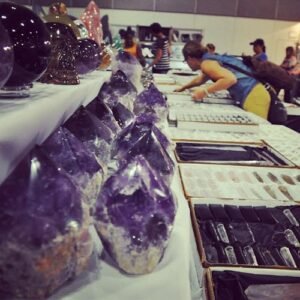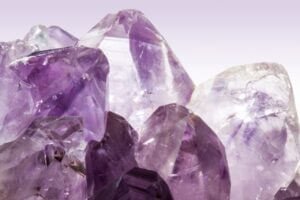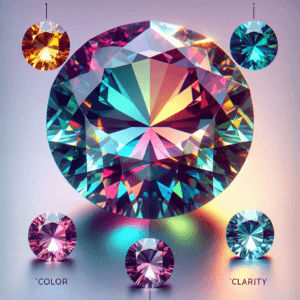What Are The 4 C’s Of Gemstones?
What Are The 4 C’s Of Gemstones? Getting acquainted with the world of gemstones? You might have heard some experienced jewelers and gem enthusiasts mention the 4 Cs of gemstones. This is not to be confused with the 4 C’s of diamonds, though they do bear some fundamental similarities. The 4 C’s in question stand for color, clarity, cut, and carat weight – fundamental factors that greatly influence the value and unique characteristics of a gemstone. This engaging article will equip you with the knowledge you need to become a more informed and savvy gem lover or collector.

Understanding the 4 C’s of Gemstones
When dealing with gemstones, it’s crucial to understand the 4 C’s—Carat, Cut, Color, and Clarity—these form the standard for gemstone evaluation worldwide. They serve as the grading system that gemologists use to describe and classify gems. The 4 C’s can significantly influence a gemstone’s value and are essential factors to consider when purchasing any gemstone.
Concepts behind ‘The 4 C’s’
The 4 C’s of gemstones—Carat, Cut, Color, and Clarity—are a fundamental classification system in the gemstone industry. They provide an organized and universal way to value gemstones based on specific criteria. The “4 C’s” were initially developed for diamonds, but the system has since been adopted for all gemstones because of its effectiveness in facilitating fair trade and comparison.
Why the 4 C’s matter in gemstones
The 4 C’s are essential in gemstones because they provide a standard measurement to judge the quality, rarity, and ultimately, the value of the gemstone. They give the buyer a clearer understanding of what they are buying, while also making sure that the seller is accurately and consistently describing their product. By prioritizing your preferences among the 4 C’s, you can efficiently navigate and personalize your gemstone shopping experience.
The First C: Carat
Carat refers to a gemstone’s weight, not its size, contrary to what some might think. The term’s origin is derived from the carob seeds that were historically used as counterweights in the balance scales used to weigh gemstones.
Definition and origin of ‘Carat’
The term ‘Carat’ is derived from the Greek word ‘keration’ meaning carob seed. Ancient traders used these carob seeds as counterweights for the balance scales due to their surprisingly consistent weight. Nowadays, one carat is equivalent to 200 milligrams in the gemstone world.
How is carat determined and measured
Carat of a gemstone is determined by weighing it with a highly accurate digital scale. Since a single carat is very light—roughly equivalent to two staples—the scale must be sensitive to incredibly slight differences in weight to ensure accurate measurement.
The relationship between carat and gemstone size
Although carat refers to the weight, not the size of the gemstone, the two are related. As you’d expect, heavier gems tend to be larger. However, it’s important to note that this relationship isn’t always linear due to the varying densities of different gemstone types.
How does carat affect gemstone value?
In the world of gemstones, size does matter. Higher carat weight often translates to a higher price. However, this is subject to the gemstone’s quality and the other three C’s—color, cut, and clarity. A larger gemstone with poor color and clarity may not be as valuable as a smaller gemstone of superior quality.

The Second C: Cut
The cut of a gemstone is not just about its shape, but also how effectively it retrains and reflects light.
Definition of ‘Cut’ in the context of gemstones
In the context of gemstones, ‘Cut’ doesn’t mean shape, but how well the gemstone has been cut from its rough form. It includes elements such as symmetry, proportions, and polish which determine how the gem will interact with light.
Different types of gemstone cuts
There are numerous ways to cut a gemstone, each resulting in a distinct style. Some popular gemstone cuts include round brilliant, oval, pear, princess, and cushion cuts. Each cut unleashes a unique pattern of brightness, fire, and scintillation.
Impact of cut on gemstone’s brilliance
The cut of a gemstone greatly influences its brilliance—the brightness created by the combination of all the white light reflections from the surface and the inside of a polished gemstone. A well-cut gemstone reflects light to the maximum degree while poorly cut gems lose light out of the sides and bottom.
How cut affects the gemstone value
Much craftsmanship and expertise are required to cut a gemstone properly, enabling it to reveal its best potential. Therefore, a cut impacts the value of a gemstone significantly. A well-cut gemstone might fetch a higher price owing to its superior light performance.
The Third C: Color
Color is one of the most critical factors when determining a gemstone’s value, and different gems are judged by different color standards.
Role of Color in determining gemstone’s value
The color of a gemstone plays a dominant role in determining its value. Gemstones are often valued for their vivid, intense colors, although some are more valued for their lighter hues. The value also depends on a gemstone’s color consistency and saturation.
How gemstone color is evaluated
Gemstone color is evaluated based on three dimensions—hue, tone, and saturation. Hue is the fundamental color of the gemstone. Tone refers to how light or dark the color is, while saturation describes the intensity or purity of the color.
Color grading scale for gemstones
Gemstones are graded on their color from a grading scale developed by GIA (Gemological Institute of America), which ranges from ‘D’ (colorless) to ‘Z’ (light color). But, it’s reasonable to remember that not every gemstone type is graded the same way. Some types of gemstones, like certain fancy-colored diamonds, can be more valuable with more intense color.
Impact of color on the appearance and value of gemstones
Color can drastically change the appearance of gemstones, often causing them to appear more desirable. The richness and consistency of a gemstone’s color can also significantly increase its value.

The Fourth C: Clarity
The clarity of a gemstone describes the absence of inclusions and blemishes.
Definition of ‘Clarity’ in the gemstone industry
In the gemstone industry, clarity refers to a gemstone’s internal and external flaws—known as inclusions and blemishes, respectively. Inclusions reflect the conditions in which the gemstone formed, and it’s incredibly rare to find a gemstone that has no inclusions.
Clarity grading system
The clarity of a gemstone is graded by viewing it under ten-power (10x) magnification, which is the industry standard. This can range from “Included” (inclusions and/or blemishes visible to the naked eye) to “Internally Flawless” (no inclusions and only small blemishes visible under 10x magnification).
Influences of clarity on gemstone appearance and price
The presence of inclusions and blemishes can affect a gemstone’s appearance and also its value. High-clarity gemstones are much rarer, especially in larger sizes, and therefore they command a higher premium.
How clarity is examined
Gemstones are examined for clarity by viewing them under 10x magnification. Gemologists inspect them from all angles to identify and clock the inclusions and blemishes that determine the gemstone’s clarity grade.
Factors Affecting the 4 C’s
Several factors can influence a gemstone’s 4 C’s. These include features that nature provided, human input, and the technology applied during its journey from the rough stone to the finished gem.
How human factors influence the 4 C’s
The skills of the gemstone cutter significantly influence the cut of the gemstone, potentially enhancing its color and clarity. The skill and intent of the cutter can directly impact the carat weight of the finished gem, as some may choose to cut a gem a certain way to increase its weight, even if it means sacrificing other aspects.
Influence of nature on the 4 C’s
Mother Nature plays a significant role in the 4 C’s. The conditions in which the gemstone is formed can affect all of these factors. For example, gemstones that formed in the pristine geological environment might have better clarity, while others gained rich colors from the trace elements present during their formation.
Role of technology in improving the 4 C’s
Technology has played a significant role in maximizing the 4 C’s of gemstones, from advanced mining techniques ensuring less damage to gems in their rough state to precision cutting and polishing machines that optimize the cut, maximizing carat weight, color, and clarity.

The Fifth C: Certification
Certification provides a professional validation of a gemstone’s 4 C’s and adds an additional level of trust and confidence in the buying process.
Importance of gemstone certification
A gemstone certificate provides an unbiased verification of a gemstone’s qualities and value. It ensures buyers that the gemstone they are investing in has been professionally evaluated.
Standard gemstone certification process
In a standard gemstone certification process, gemstones are examined by experienced gemologists using specialized tools and equipment. The gemstone’s carat weight, cut, color, and clarity are then documented in a certificate.
Understanding the information in a gemstone certificate
A gemstone certificate contains detailed information about the gemstone’s physical properties and quality characteristics. For example, it will quantify the carat weight, describe the cut, note the color, and determine the clarity. Some gemstone certificates may also include a map of the gemstone’s inclusions.
Common Misconceptions about the 4 C’s
There are many misconceptions about the 4 C’s of gemstones. Understanding these can help you make a more informed buying decision.
Myths and truths about carat weight
One common myth is that carat refers to the size of a gemstone when it refers to the gemstone’s weight. While larger gemstones typically have a higher carat weight, this is not a hard and fast rule as the density of different types of gemstones can vary.
Common misunderstandings about color grades
People often misunderstand that only diamonds have a color grading scale. The reality is that all gemstones have a color grading scale, but each type of gemstone is judged by its scale.
Misconceptions about cut styles and shapes
Many believe that a gemstone’s cut refers to its shape. While this might be partially correct, the cut primarily refers to how well the gemstone facets interact with light, which plays a substantial role in the gemstone’s brilliance.
Clarity confusion and common mistakes
People tend to believe higher clarity always means a better gemstone. However, some inclusions do not affect the beauty of the gemstone and might even give it character. Moreover, inclusions can be quite useful from an identification point of view, as they can often provide clues about the gemstone’s origin and help distinguish between natural and synthetic stones.

Selecting Gemstones Using the 4 C’s
Using the 4 C’s as a guideline can significantly simplify the gemstone selection process.
Guidelines for choosing based on carat
Deciding on carat weight largely comes down to personal preference. If a larger gemstone fits within your budget, and the other C’s are up to mark, then go for it. However, a smaller gemstone of a superior grade can offer more brilliance and value.
Tips for selecting the ideal cut
The ideal cut depends on your preference for brilliance vs. size. Brilliant cuts like the round brilliant can offer maximum sparkle, whereas other cuts like the emerald cut offer a distinct, dramatic flash of light.
Choosing the acceptable color range
The acceptable color range for gemstones is subjective and depends on personal preference. Some people might prefer the purer color of higher-grade gemstones, while others might prefer the deeper color of lower-grade stones. It’s always essential to see the gemstone in person to assess its color accurately.
Understanding clarity for intelligent decision-making
While gemstones with fewer inclusions are more valuable, some might consider gemstones with unique inclusions due to their uniqueness and character. What’s critical is to understand that clarity isn’t always about perfection, but the overall impact on the appearance and integrity of the gemstone.
Conclusion: The 4 C’s in the Gemstone Industry
The 4 C’s have revolutionized the gemstone industry by providing an objective method for evaluating and comparing gemstones.
How the 4 C’s revolutionized the gemstone industry
The 4 C’s of gemstones—carat, cut, color, and clarity—have brought about a standardized system for evaluating gemstones. With this framework, gemologists can communicate about the quality of gemstones more effectively and accurately.
The future of the 4 C’s in gemstone sourcing and grading
The 4 C’s will continue to play a significant role in gemstone sourcing and grading in the future. With advancements in technology, the accuracy in grading and further customization of the 4 Cs to different kinds of gemstones could be expected. Are Star Sapphires Worth Anything?
Final thoughts on the importance of understanding the 4 C’s
Understanding and weighing the 4 C’s based on personal preference can make sure that you’re making the right gemstone investment. Consider which of the 4 C’s matter the most to you, and let that guide you in your selection. At the end of the day, your gemstone’s beauty is in your eyes. The right gemstone for you is one that brings you the greatest joy when you see it.



